DFI NF4 SLI-DR Expert – Can the best get better?
by Randi Sica on November 25, 2005 12:05 PM EST- Posted in
- Motherboards
Extreme Overclocking performance
As mentioned at the beginning of the review, we will now step away from the standard AnandTech review and present you with what many have asked to see with a board of this capability - Extreme overclocking results. In this phase, we’re not looking for the ultimate CPU top overclock, but rather how high we could push the FSB up on each CPU and remain 100% stable.
We’ll begin with the 4000+ San Diego aboard the Expert and 2x512MB OCZ PC4800EL dual channel Platinum Elite Limited Edition RAM modules at 2-3-3-8 1T with voltage bumped to 2.96V for stability at the tighter than advertised timings, at their rated speed at the 150 divider. Multiplier was reduced to keep the CPU at its rated CPU MHz.
This was the maximum stable and attainable FSB that the 4000+ San Diego was capable of performing.
We switched to the 3500+ Winchester to see what this board was made of. Previously on the original SLI-D, we could attain 500 MHz FSB, but only after booting at 425 MHz FSB and using ClockGen to climb up to the maximum stable FSB of 500 MHz. For this test, we installed the other part of the previously successful FSB test, 2x256MB G.Skill PC4400 LE RAM modules. To be quite honest, after using the 100 divider during this phase of testing, any of the BH-5 or TCCD modules that we had on hand would have worked just fine for these tests.
With the Expert, we went for the throat immediately and attempted a successful boot from the BIOS into Windows at 500 MHz FSB. This was a breeze to accomplish and stability was superb. LDT was set to auto, but showed in A64 Tweaker at 2.5, equating to a total LDT speed of 2500 MHz, which is just phenomenal. LDT voltage was set at 1.4V as well as Northbridhge voltage set at 1.96V.
A 16M SuperPi was run to assess stability before moving up the FSB ladder.
Our next step up saw us boot into Windows at 510 MHz FSB. This didn’t prove to be a stable FSB for running any benchmarks, but was a nice accomplishment nonetheless. The board with this CPU would not boot to Windows at any higher FSB speed at this point, so we used ClockGen to find the CPU’s limit, which ended up at 512 MHz FSB as illustrated earlier in the review. Again, a link to the CPU-Z verification can be found here.
The final phase was to determine the highest stable, benchmark-able FSB MHz that the CPU and board were capable of performing, which after much testing ended up being 505 MHz FSB. Runs of Aquamark3, 3Dmark 2003 and 2005, and a 32M SuperPi were run to confirm stability and repeatability.
Due to time constraints in compiling results for this review, top memory overclocking was not tested. We will do more testing with the 3500+ Winchester for a future review to see how far we can push the RMA modules in our arsenal. Previously with this CPU, we had reached 370 MHz 1:1 (2x256MB G.skill PC4400 LE) and it will be interesting to see how our newest modules can stack up to this CPU’s capability.
As mentioned at the beginning of the review, we will now step away from the standard AnandTech review and present you with what many have asked to see with a board of this capability - Extreme overclocking results. In this phase, we’re not looking for the ultimate CPU top overclock, but rather how high we could push the FSB up on each CPU and remain 100% stable.
We’ll begin with the 4000+ San Diego aboard the Expert and 2x512MB OCZ PC4800EL dual channel Platinum Elite Limited Edition RAM modules at 2-3-3-8 1T with voltage bumped to 2.96V for stability at the tighter than advertised timings, at their rated speed at the 150 divider. Multiplier was reduced to keep the CPU at its rated CPU MHz.
This was the maximum stable and attainable FSB that the 4000+ San Diego was capable of performing.
We switched to the 3500+ Winchester to see what this board was made of. Previously on the original SLI-D, we could attain 500 MHz FSB, but only after booting at 425 MHz FSB and using ClockGen to climb up to the maximum stable FSB of 500 MHz. For this test, we installed the other part of the previously successful FSB test, 2x256MB G.Skill PC4400 LE RAM modules. To be quite honest, after using the 100 divider during this phase of testing, any of the BH-5 or TCCD modules that we had on hand would have worked just fine for these tests.
With the Expert, we went for the throat immediately and attempted a successful boot from the BIOS into Windows at 500 MHz FSB. This was a breeze to accomplish and stability was superb. LDT was set to auto, but showed in A64 Tweaker at 2.5, equating to a total LDT speed of 2500 MHz, which is just phenomenal. LDT voltage was set at 1.4V as well as Northbridhge voltage set at 1.96V.
A 16M SuperPi was run to assess stability before moving up the FSB ladder.
Our next step up saw us boot into Windows at 510 MHz FSB. This didn’t prove to be a stable FSB for running any benchmarks, but was a nice accomplishment nonetheless. The board with this CPU would not boot to Windows at any higher FSB speed at this point, so we used ClockGen to find the CPU’s limit, which ended up at 512 MHz FSB as illustrated earlier in the review. Again, a link to the CPU-Z verification can be found here.
The final phase was to determine the highest stable, benchmark-able FSB MHz that the CPU and board were capable of performing, which after much testing ended up being 505 MHz FSB. Runs of Aquamark3, 3Dmark 2003 and 2005, and a 32M SuperPi were run to confirm stability and repeatability.
Due to time constraints in compiling results for this review, top memory overclocking was not tested. We will do more testing with the 3500+ Winchester for a future review to see how far we can push the RMA modules in our arsenal. Previously with this CPU, we had reached 370 MHz 1:1 (2x256MB G.skill PC4400 LE) and it will be interesting to see how our newest modules can stack up to this CPU’s capability.


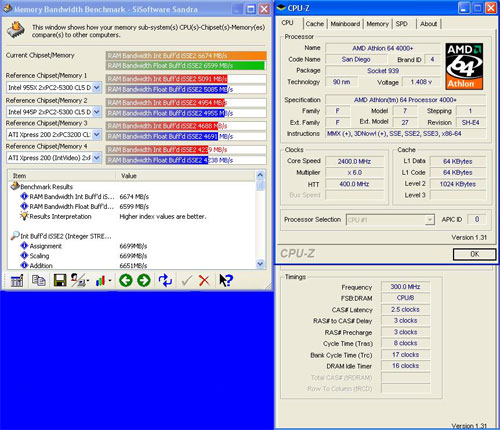
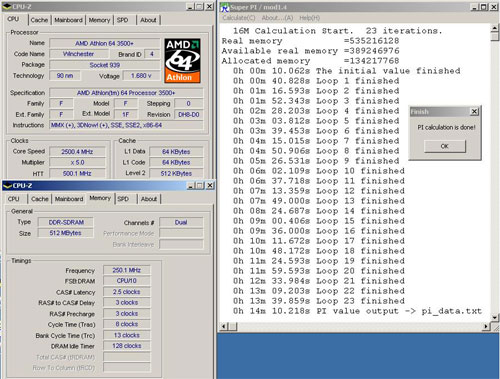
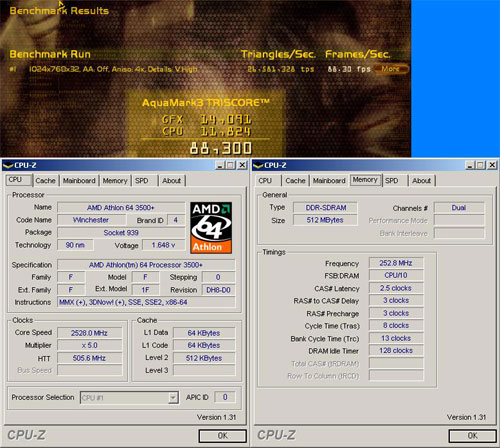
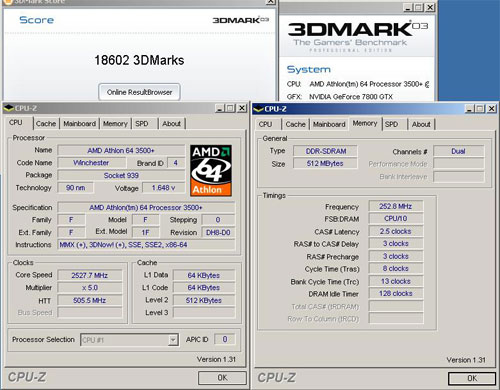
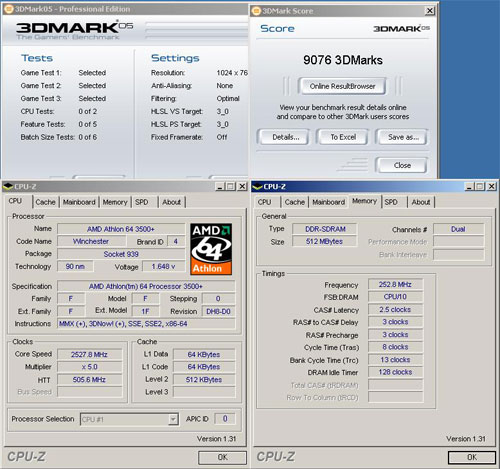
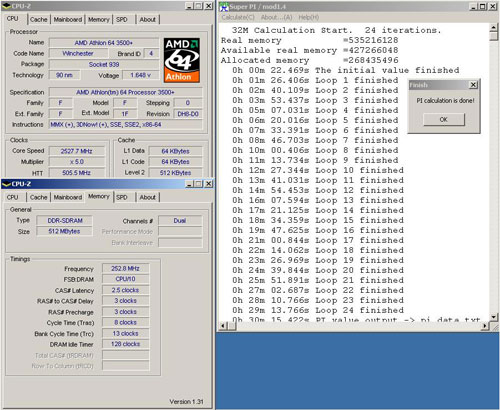








40 Comments
View All Comments
Hardass1 - Sunday, February 19, 2006 - link
Another well done review Sir.Hardass.
lopri - Saturday, November 26, 2005 - link
If you had to pick one, which one would you pick? A8N32-SLI or Expert? Please don't tell me "Both are good", "They're different animals" or anything in that sense. Most of us have to pick ONE and that exact question is what we want to know. I'd venture to say what matters are following two:1. Overclockability
2. Stability
Fetures, layouts, etc... yeah.. they are all good and nice, but what really matters are whether the overclock is stable. And that's what brought DFI here today. Could you comment on it? If you had a choice to pick JUST ONE, which one would you pick?
Great review anyway. I'm actually happy that AT is becoming more enthusiast-friendly and looking forward to the next review. (Possibly Opteron Overclocking review?)
Thanks.
lop
RSica - Sunday, November 27, 2005 - link
Hi Lop:)I'll be honest in telling you I have not had my hands on the Asus board to know it's full overclocking abilities, so I really can't give you an opinion on which board to choose. Wesley could give you full insight on that one.
I go way back in the overclocking business, having hooked up with my best buds OPPAINTER and DDTUNG back in the day. At that time we were modding and overclocking each generation of Abit AMD based boards starting with the KG7 and culminating with the NF7-S, which we were pre-production testing prior to it's retail release. I've also had a play with Epox, Gigabyte, and the famous Shuttle A64 board.When I recieved the original SLI-D back in January it was an overclockers dream come true.All the voltage and overclocking/memory options and it overclocked way easy compared to the norm.(Thank you Oskar Wu:))
The Expert is more of the same but much better. I am a bit biased on a personal level about the board, and if you had just asked about it, I'd have given a thumbs up.
Thanks for your comments !
Randi
Scrith - Wednesday, November 30, 2005 - link
Does this use the same chipset as the A8N32-SLI? If not, why not, and where are the competitors for that board?Heckler 5th - Sunday, December 4, 2005 - link
how come the box the reviewer received already has that "anandtech gold medal" sticker on there? hmmm, kinda fishy... LOLcbkia - Saturday, November 26, 2005 - link
Under the extreme oc page, the pic showing the HTT @ 400MHz and RAM @ 300MHZ 2.5-3-3-8 but the sisoft is only 6674 MB/s? 300MHz should be displaying something near 8GB/sRSica - Sunday, November 27, 2005 - link
That would be true if not running at 2400Mhz.All HTT and Memory overclocking tests were done at a reduced multiplier. Each multiplier also has an effect on system bandwidth in the way the A64 responds to them.If I had chosen to run 7 and a total CPU Mhz of 2800, you would have most likely seen the 8000mb/s figure.In contrast, the stock 4000+ at 12x200Mhz with tight timings will average 5600-5700mb/s.
Another consideration is that with the bios used which made it more ram overclocking friendly, that there was possibly a relaxation of some of the bios register settings, which can also reduce bandwidth a bit in the name of pushing the memory higher in Mhz.
Thanks for your comments !
Randi
RobFDB - Saturday, November 26, 2005 - link
What i'm really interested in is if this board suffers from the same problem as my Ultra-D with PC4000 VX memory (the infamous cold boot issue)?I don't really want to pick this board up and have it suffer from the same problem. Not that i've tried my VX with the latest beta bios, but that's besides the point.
RobFDB - Tuesday, November 29, 2005 - link
Can anyone confirm or deny that the cold boot issue exists with this board?yacoub - Saturday, November 26, 2005 - link
If it had passive cooling like the A8N32-SLI I'd be more interested.